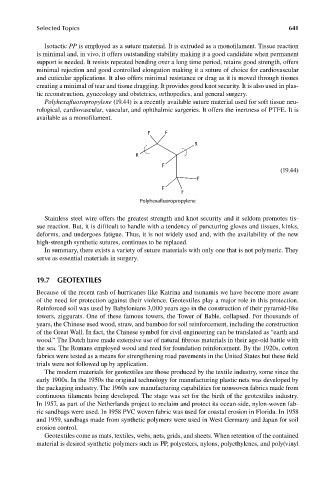Page 678 - Carrahers_Polymer_Chemistry,_Eighth_Edition
P. 678
Selected Topics 641
Isotactic PP is employed as a suture material. It is extruded as a monofi lament. Tissue reaction
is minimal and, in vivo, it offers outstanding stability making it a good candidate when permanent
support is needed. It resists repeated bending over a long time period, retains good strength, offers
minimal rejection and good controlled elongation making it a suture of choice for cardiovascular
and cuticular applications. It also offers minimal resistance or drag as it is moved through tissues
creating a minimal of tear and tissue dragging. It provides good knot security. It is also used in plas-
tic reconstruction, gynecology and obstetrics, orthopedics, and general surgery.
Polyhexafl uoropropylene (19.44) is a recently available suture material used for soft tissue neu-
rological, cardiovascular, vascular, and ophthalmic surgeries. It offers the inertness of PTFE. It is
available as a monofi lament.
F F
R
R
F
(19.44)
F
F
F
Polyhexafluoropropylene
Stainless steel wire offers the greatest strength and knot security and it seldom promotes tis-
sue reaction. But, it is difficult to handle with a tendency of puncturing gloves and tissues, kinks,
deforms, and undergoes fatigue. Thus, it is not widely used and, with the availability of the new
high-strength synthetic sutures, continues to be replaced.
In summary, there exists a variety of suture materials with only one that is not polymeric. They
serve as essential materials in surgery.
19.7 GEOTEXTILES
Because of the recent rash of hurricanes like Katrina and tsunamis we have become more aware
of the need for protection against their violence. Geotextiles play a major role in this protection.
Reinforced soil was used by Babylonians 3,000 years ago in the construction of their pyramid-like
towers, ziggurats. One of these famous towers, the Tower of Bable, collapsed. For thousands of
years, the Chinese used wood, straw, and bamboo for soil reinforcement, including the construction
of the Great Wall. In fact, the Chinese symbol for civil engineering can be translated as “earth and
wood.” The Dutch have made extensive use of natural fibrous materials in their age-old battle with
the sea. The Romans employed wood and reed for foundation reinforcement. By the 1920s, cotton
fabrics were tested as a means for strengthening road pavements in the United States but these fi eld
trials were not followed up by application.
The modern materials for geotextiles are those produced by the textile industry, some since the
early 1900s. In the 1950s the original technology for manufacturing plastic nets was developed by
the packaging industry. The 1960s saw manufacturing capabilities for nonwoven fabrics made from
continuous filaments being developed. The stage was set for the birth of the geotextiles industry.
In 1957, as part of the Netherlands project to reclaim and protect its ocean-side, nylon-woven fab-
ric sandbags were used. In 1958 PVC woven fabric was used for coastal erosion in Florida. In 1958
and 1959, sandbags made from synthetic polymers were used in West Germany and Japan for soil
erosion control.
Geotextiles come as mats, textiles, webs, nets, grids, and sheets. When retention of the contained
material is desired synthetic polymers such as PP, polyesters, nylons, polyethylenes, and poly(vinyl
9/14/2010 3:44:04 PM
K10478.indb 641 9/14/2010 3:44:04 PM
K10478.indb 641

